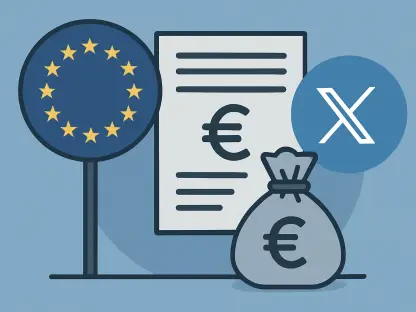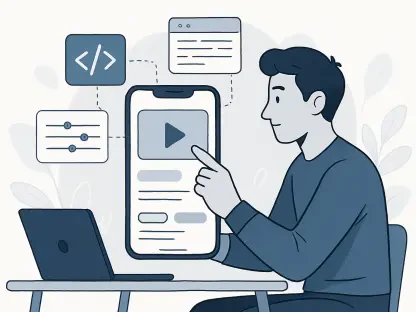In the ever-evolving world of mobile technology, the app ecosystem stands as a battleground for innovation and market dominance, where millions of users now interact with compact, seamless experiences embedded within larger applications. Often, they don’t even realize they’ve stepped into a mini app, but these bite-sized digital tools are transforming engagement on iOS devices, and Apple has taken notice with a bold initiative aimed at developers. This review dives into the intricacies of a program designed to empower creators of such mini apps, exploring how it reshapes the landscape for developers navigating a fiercely competitive digital market.
Understanding the Mini Apps Partner Program
Apple’s latest offering to developers focuses on mini apps—self-contained experiences crafted using web technologies like HTML5 and JavaScript, hosted within larger native iOS applications. These mini apps provide quick, functional interactions without the need for standalone downloads, making them a lightweight alternative to traditional apps. The program, a strategic pivot by Apple, seeks to bolster innovation by providing specific incentives and guidelines for developers who integrate these tools into their platforms.
At its core, this initiative is about creating a symbiotic relationship between Apple and developers. By supporting mini apps, Apple not only enhances user experiences within its ecosystem but also ensures that developers have a structured pathway to reach audiences. This move comes at a time when the demand for streamlined, in-app functionalities is surging, positioning the program as a timely response to market needs.
Key Features and Incentives
Financial Benefits with Reduced Commissions
One of the most striking aspects of this program is the reduced commission rate of 15% on in-app purchases for mini apps. This stands in stark contrast to Apple’s standard rates, offering a substantial financial relief for developers. Such a reduction allows creators to retain more revenue, which can be redirected toward improving their offerings or scaling their operations.
This financial incentive isn’t just a perk; it’s a catalyst for growth. Developers can experiment with new features or enhance user interfaces without the heavy burden of high commission fees. This could lead to a wave of creativity in the mini app space, potentially elevating the quality of digital experiences available on iOS.
Leveraging Apple’s Technology Stack
Beyond monetary benefits, the program mandates the use of Apple-specific tools such as the Advanced Commerce API and Declared Age Rating API. These technologies ensure that mini apps adhere to strict standards for trust, safety, and age-appropriateness. While this adds a layer of complexity for developers, it also guarantees a consistent and secure user experience across the platform.
The integration of these tools reflects Apple’s commitment to maintaining control over its ecosystem. Developers gain access to robust systems for handling transactions and content moderation, but they must align closely with Apple’s guidelines. This balance of support and oversight shapes how mini apps are built and distributed, reinforcing Apple’s influence in the space.
Performance in the Real World
Diverse Applications Across Industries
Mini apps have already carved out a significant presence within popular native iOS platforms, enhancing user engagement in various sectors. For instance, messaging giants like WeChat host mini apps from companies such as Booking.com and Spotify, enabling users to book travel or stream music without leaving the chat interface. This seamless integration showcases the versatility of mini apps in transforming routine interactions.
In other domains, such as gaming hubs like Discord, mini apps offer quick games or interactive tools that keep users engaged within a single environment. Even AI-driven platforms like ChatGPT are embedding mini apps from creators like Canva, blending creativity with conversation. These examples highlight how mini apps are redefining convenience across travel, entertainment, and social networking.
Impact on User Engagement
The ability of mini apps to deliver focused, immediate value directly impacts how users interact with native apps. By embedding services like mini games or chatbots, developers can retain user attention longer, reducing the need to switch between applications. This trend points to a shift in behavior, where users increasingly expect all-in-one solutions within their favorite platforms.
Such a shift also poses a challenge to the traditional App Store model, as transactions and engagement may migrate to these embedded ecosystems. Apple’s program, with its reduced commission, appears to be a calculated effort to keep developers invested in the iOS framework while acknowledging the growing influence of alternative distribution channels.
Challenges and Competitive Dynamics
Navigating Strict Compliance Standards
Despite its benefits, the program comes with stringent eligibility criteria that may deter some developers. Adherence to the Apple Developer Program License Agreement and App Review Guidelines is non-negotiable, requiring mini apps to meet high standards for data security and content filtering. The mandatory integration of Apple’s in-app purchase system further tightens control over transactions.
This rigorous review process, while ensuring quality, can be a hurdle for smaller developers or those unfamiliar with Apple’s ecosystem. The time and resources needed to comply might limit participation, particularly for innovative startups looking to experiment with mini app formats. Balancing creativity with compliance remains a key challenge.
Competitive Pressures in the Digital Space
The rise of AI-driven platforms and alternative ecosystems adds another layer of complexity. As mini apps gain traction within apps like ChatGPT, there’s a risk that user engagement could shift away from the App Store’s centralized model. Apple’s strategic reduction in commission rates can be seen as a preemptive move to retain developer loyalty amidst these emerging competitors.
Moreover, the control Apple exerts over transactions might stifle flexibility for developers seeking to explore other monetization models. While the program offers financial relief, it also binds creators to Apple’s infrastructure, potentially limiting their ability to adapt to rapidly changing market trends. This dynamic underscores the tension between support and restriction.
Final Thoughts and Next Steps
Reflecting on this review, it is evident that Apple’s initiative strikes a delicate balance between incentivizing developers and safeguarding its own interests. The reduced commission rate of 15% stands out as a significant boon, fostering an environment where innovation can thrive. However, the strict compliance requirements and mandatory use of Apple’s technologies highlight the company’s unwavering grip on its ecosystem.
Looking ahead, developers are encouraged to weigh the benefits of financial savings against the demands of integration and oversight. For those ready to navigate Apple’s guidelines, joining the program offers a unique opportunity to tap into a growing market of mini app users. Exploring partnerships with native apps to host mini experiences could serve as a practical next step.
Additionally, keeping an eye on how competitors and regulatory bodies respond to Apple’s policies is crucial. As the digital landscape continues to evolve, staying adaptable and informed will empower developers to leverage this program effectively. This initiative marks a pivotal moment, and its long-term success hinges on how well it can foster genuine collaboration between Apple and the developer community.









